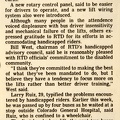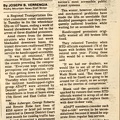Accent on Living Summer 1983
Transportation
Denver Busing Its Disabled
Highlighted text: A failure in many cities, Denver has made accessible mass transportation work as an increasing number of disabled use it everyday.
The Rapid Transportation District (RTD) in Denver is one of the most accessible transit systems in the nation – and the disabled community will take credit for it.
For the last ten years, since 1973 when the RTD initiated “Handy-Ride,” a door-to-door subscription service, accessible buses have been a real issue. To date, disabled advocates have been the winners.
“It has been a political victory for us,” says Wade Blank, co-director of the Atlantis Community, a highly active disabled group in Denver. He explains that they did not rely on 504 but instead used a successful strategy.
Blank said that in 1973 when HandyRide was implemented, the disabled took the same stance the Blacks took during the civil right movement. “Separate in not equal. We agree that this type of service was fine, but what we really wanted was to have the entire bus system accessible. HandyRide would just be an extra.”
Disabled people began demonstrating for accessibility on public buses – and in 1978 RTD agreed to develop mass transit accessibility. By June, 1982, it had met its commitment of having fifty percent of the buses accessible (two hundred twenty buses were retrofitted with lifts and one hundred twenty-seven new buses purchased in 1981 had lifts).
In the meantime, however, Blank said the RTD reneged on its commitment of total accessibility because it announced in November, 1981, that eighty-nine buses to be delivered in late 1983 would not be lift equipped. These new buses are articulated buses, twice as long as regular buses.
Wheelchair Ridership
Graph - Shows ridership by month in 1981, 1982, and part of 1983 (up to April. ) Ridership pretty much rises except in fall and winter there is a downturn, and July of 1982 a sharp drop to a low point of about 300. Highest mark is almost 1300 in October 1982.
Caption reads: There was a sharp drop in wheelchair ridership in July, 1982, because there were no accessible buses running.
- Created on
- Thursday 11 July 2013
- Posted on
- Tuesday 10 May 2016
- Tags
- accessible transit, Denver RTD, mainline accessible transit, paratransit, separate but equal, Wade Blank
- Albums
- Visits
- 1450
- Rating score
- no rate
- Rate this photo


0 comments